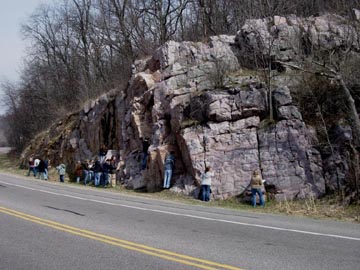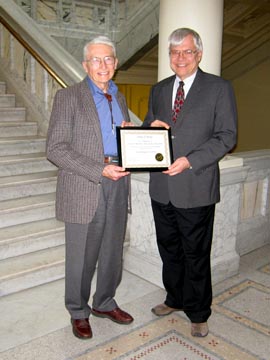Victory at Point of Rocks!
 |
Point of Rocks road cut. Photo by Dr. Diane Kiesel of the UW Baraboo Center. The students shown are from one of her classes. |
On Friday, February 19, 2010, the State Historical Society's Board for Historic Sites approved the nomination of the Point of Rocks outcrop on US Highway 12 in the South Baraboo Range for addition to the State's list of Historic Sites. The nomination with the Board's approval will be forwarded to the National Park Service for consideration for the National List. Such designation would protect the road cut from destruction for highway alterations and would recognize its historic significance. Approvals will be announced within a month or two.
The Point of Rocks, which was named by the Department of Transportation, is a prominent outcrop of the upper part of the Baraboo Quartzite on the east side of the highway about four miles south of Baraboo at the south end of a tight curve toward the east. It is very important to geologists because it has the best exposure known of sedimentary features in the Quarzite, including cross bedding, reactivation surfaces, soft-sediment deformation, and ripple marks. It also has a zone of a complexly deformed and metamorphosed fine-grained sediments within the Quartzite. There are multiple cleavages, whose relationships to one another are challenging for structural geologists (it is a twin to the exposure along Skillet Creek about a mile to the east). This deformed interval also has fine examples of boudinage and it is characterized by the layered silicate pyrophyllite (metamorphic equivalent of kaolinite).
 |
Robert H. Dott, Jr., Professor Emeritus, left, receives the certificate of the historic listing from Michael E. Stevens, State Historic Preservation Officer. |
The Point of Rocks road cut is historically important because of the pioneering work in structural and metamorphic geology by Charles R. Van Hise and associates in the late 19th century. Van Hise was both Professor of Geology and Director of a USGS Lake Superior District Office established at the UW for the investigation of all of the Lake Superior iron ranges, including Baraboo. Confronted with generally poor exposures but complex structure in those ranges, Van Hise and his army of assistants perfected the use of outcrop-scale structures such as bedding-cleavage relationships, drag folds, way-up criteria, etc. to infer larger, inter-outcrop scale structures. These principles became universally recognized and applied worldwide in the early 20th Century thanks largely to the contributions of the "Wisconsin School of Geology."
Together with Van Hise Rock, exposures at Devils Lake, and elsewhere in the Baraboo District, the Point of Rocks was key to inferring the large synclinal structure of the District around 1900. Thenceforth, the accessibility of the Baraboo exposures has made the area a mecca for geologists from all over the USA and even from abroad to study these features. In spring and fall, countless buses and vans from dozens of colleges visit the Baraboo Hills. Many stop at Point of Rocks.
In 2007, thanks to the collective efforts of department faculty Basil Tikoff, Laurel Goodwin, and Gordon Medaris, State Geologist Jamie Robertson, and John Attig of the Wisconsin Geological and Natural History Survey and Professor Emeritus Robert H. Dott, Jr., the Department of Transportation was persuaded to redesign a new four-lane alignment for US 12 to avoid the treasured road cut. The DOT people were very receptive and agreed to re-route the new highway slightly. As part of the negotiations, the DOT suggested having a study performed of the Eligibility for Historical Listing of the site. This received a positive determination from the Historical Society, which satisfied the DOT as sufficient protection. Professor Dott then felt that they should apply for actual listing rather than just eligibility. He has been working for the past three years on an application for listing, which turned out to be a long and involved process. Thanks to the generous help of Daina Penkiunas of the Historical Preservation Office of the Historical Society, the nomination was completed and the rest is history.
posted Feb. 22, 2010